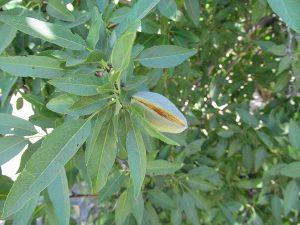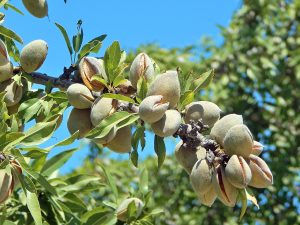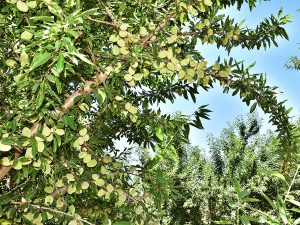
Director, Member Relations
This report covers conditions and observations made between Monday, June 6 and Monday, July 4, 2016.
Northern Region –The final weeks of Spring brought warm, but comfortable temperatures to the Sacramento Valley. However, Summer arrived forcefully in the region as temperatures rapidly rose to and above 100 degrees in the second half of the period. Daily maximum readings declined slowly from the mid and upper 90’s at the start of the period, dipping into the mid 70’s by mid-month. Readings then climbed rapidly back to near record levels for the balance of the period, with only a slight moderation to just below 100 degrees in time for the Fourth of July holiday weekend. Morning low temperatures reflected the daytime heat, with readings reported in the upper 50’s to mid-60’s.
Observers are reporting that hulls of the Nonpareil and Independence varieties have begun splitting in advanced plantings along the west side of the Sacramento Valley. With the start of the harvest scheduled to begin within a few weeks, growers have been very busy working to prepare their orchards. The higher temperatures experienced over the past few weeks increased water requirements at a time where many growers were also working to manage moisture levels in an effort to control fungal infections on the newly split hulls. Complicating matters, growers have also begun hull split treatments to control Navel Orange Worm and bait applications to control damaging species of ants on the orchard floor; both operations require a dry, firm orchard floor. Growers have also been mowing vegetation within the orchards, a continual activity during the growing season that grows more critical as the harvest approaches.
Observers have reported that growers are anticipating that shakers will begin the harvest in the first, most advanced plantings along the west side of the region during the week of July 17th. Harvest operations in other areas of the region will most likely begin around August 1st. Huller/sheller operators are also preparing for the harvest, assembling and cleaning their equipment.
Central Region – Uncomfortably hot conditions reigned over the northern San Joaquin Valley during much of June, increasing water consumption within the orchards and the stress on the developing crop. Daily maximum temperatures were reported at their most comfortable levels early in the period, with readings dipping from the upper 90’s down into the upper 70’s by mid-month. Temperatures then climbed aggressively, reaching to and above 100 degrees until the end of the period. Uncharacteristically, the high temperatures were also accompanied by light winds of 5 to 10 mph on many days, which further increased water requirements in the region’s orchards. Morning lows provided only a modest break from the day’s heat, with readings reported predominately in the upper 50’s to mid and upper 60’s.
Hull split has begun in the northern San Joaquin Valley, heralding the approaching harvest. Observers have noted that hull split in the Nonpareil and Independence varieties can be found in all areas of the region, with the most advanced degree of maturity reported along the I-5 corridor in the west side of the valley.
Growers have been very busy, working to meet the orchard’s moisture requirements, which have been driven higher by the hot conditions while performing other necessary tasks. Growers find themselves working a fine balance. In order to reduce the impact of fungal infections on the splitting hulls, growers typically reduce water applications to one-half of the tree’s consumptive use for a two-week period at the initiation of hull split. However, the high temperatures have made this a sensitive proposition as the conditions drive water needs higher. As a result, growers find themselves working to balance the desire to reduce the potential of fungal infections against increasing stress imposed by the heat.
While the region’s orchards have generally been in very good condition this year, plantings around the region can be found under increasing stress. In the most extreme conditions, leaves have wilted and withered, and the nuts themselves have become more pliable as water stress increases. Irrigation timing has been complicated by the need to complete other orchard operations. Ant bait applications, hull split treatments to control Navel Orange Worm and weed control must all be worked into irrigation schedules so that these critical tasks can be completed in a timely manner.
Growers along the west side of the region are predicting that they will start shaking the first orchards between the 20th and 27th of July.
Southern Region – Record, or near record heat dominated the first weeks of Summer in the southern San Joaquin Valley. Daily maximum temperatures during the first half of the month declined steadily from near 100 degrees in the opening days of the period, dipping into the upper 70’s and lower 80’s by mid-month. However, the arrival of Summer brought rapidly rising temperatures as a resilient high pressure system settled over the state, driving temperatures to as high as 106 degrees. Conditions were made a bit more difficult by increasing humidity, cast over the region as moist flows moved over the desert regions, farther to the south. Readings moderated slightly in the final days of the period, in time for the Independence Day holiday weekend. However, temperatures remained at uncomfortable levels, near 100 degrees. Morning low temperatures reflected the daily highs, with readings ranging from the mid 50’s at mid-month to the lower 70’s during the hottest days of the period.
Observers have reported that the hull split has begun in the advanced plantings of the Nonpareil and Independence varieties, indicating that the start of the 2016 harvest is just a few weeks away. Growers spent the past month working to meet their orchard’s moisture needs in the face of withering temperatures. While the regions orchards are in much better condition this year, benefiting from better winter rainfall and improved water availability in many areas of the region, orchards under varying degrees of stress can be found. As may be seen in the photo accompanying this report, in areas along the west side of the region where inadequate supplies of surface water force growers to rely on poor quality ground water, orchards are beginning to show signs of stress and damage from excessive salinity.
Growers spent the month preparing for the coming harvest, working to meet their orchards water requirements under the hot conditions and mowing excessive weed growth within the orchards. Fortunately, populations of web spinning mites have remained largely below damaging levels this year and widespread problems have been avoided. However, the initiation of the hull split also drives growers to begin treatments to control Navel Orange Worm as well as applications of bait formulations targeted to damaging ant species living in and on the orchard floor. This year’s high temperatures complicated work schedules during the period as growers struggled to balance their orchard’s water requirements against the need to manage pest populations, while striving to reduce the potential impacts of fungal growth on the splitting hulls.
The next scheduled report will be posted on Monday, August 1, 2016.


